13 German Sword Types: From Medieval to Modern Era
NO AI USED This Article has been written and edited by our team with no help of the AI
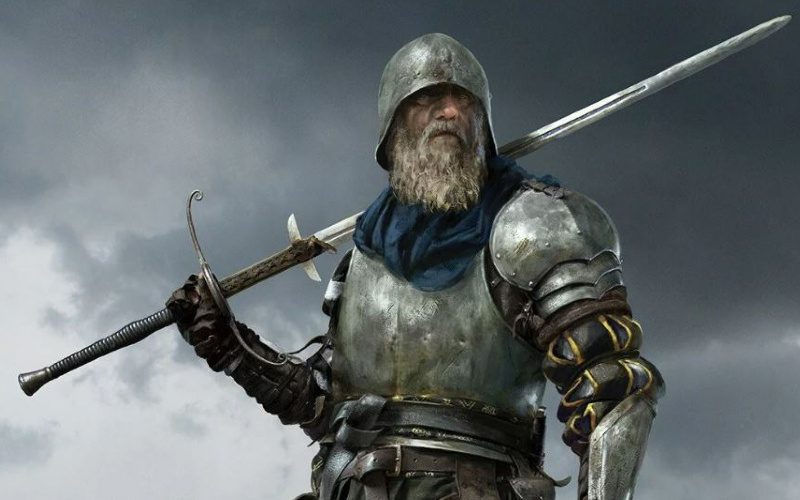
German Swords fall into the category of European swords and might just be one of the most influential, especially in the middle ages. They have the widest variety in terms of length as well as the best and most popular swords of modern media today.
In this article, we will discuss all of the German Swords, from the earliest traces of their craftsmanship to their use in the latest wars of the modern era. We will explain how they were primarily used, their history as well as the decline in the sport of unique German sword fencing.
1. Seax
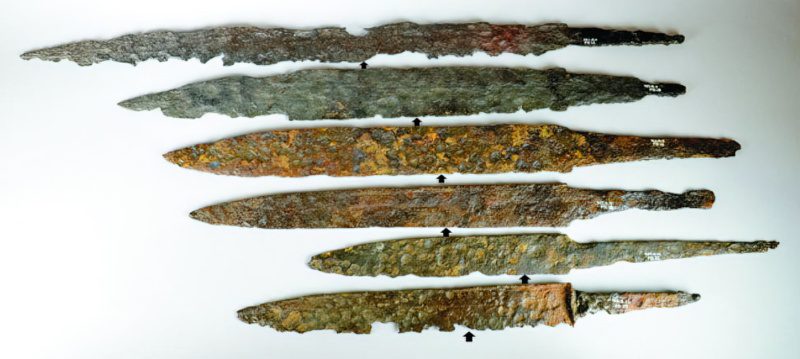
Seax is a term for a dagger or knife used among the Germanic peoples of the Migration Period and the Early Middle Ages, notably Saxony (historical North Germany), whose name originates from the weapon itself. However, due to its length, it may easily be classified in the short sword category.
The later Vikings were heavy users of this sidearm as a daily utility and in battle. It was common to find a small seax buried with Germanic men during the Viking Age.
- Blade – single-edged, short, straight with a curve or ridge at the end
- Guard – /
- Handle – straight
- Length – 14 to 24 inches (35 to 60 cm)
- Weight – 0.9 to 1.7 lbs (400 to 800 grams)
2. Migration Period Sword
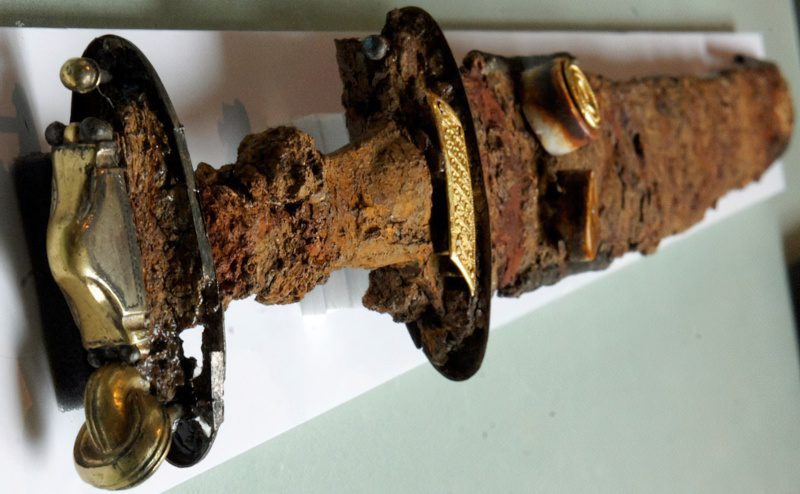
During the Migration and Merovingian period of European history, which spanned the 4th through 7th century AD, the Migration Period sword was widely used among the Germanic peoples. While the longer Spatha was used in the Roman Empire, with its collapse in the 5th century, a native sword industry in the Germanic tribes started and produced many Migration Period Swords. The later Carolingian sword or Viking sword style was developed from this weapon from the 8th to 11th century AD.
- Blade – straight, double-edged, sharp tip
- Guard – oval short
- Handle – straight, large oval pommel
- Length – 28 to 35 inches (70 to 90 cm)
- Weight – 2.2 lbs (1 kg)
3. Ulfberht Sword

The Ulfberht is a sword that has been labeled both a Viking sword and a Frankish Germanic sword. Still, recent scholars have linked it more closely to the Rhine River region (present-day France and Germany) and the Frankish Germanic tribes that lived there throughout the Middle Ages. Plenty of Germanic bladesmiths contributed to developing these swords throughout the Frankish Empire, an area far bigger than current Germany.
- Blade – straight, double-edged
- Guard – oval and disc shape, narrowed
- Handle – straight, large round pommel
- Length – 28 to 39 inches (70 to 100 cm)
- Weight – 2 to 4 lbs (0.9 to 1.8 kg)
4. Arming Sword

The German Arming sword is believed to have been inspired by the older Ulfberht swords and was possibly the first to emerge in the whole lines and manner of arming swords throughout the medieval periods of the 11th and 12th century. The Arming Sword was used by nobles and knights throughout the Crusades and into the Late Middle Ages as a one-handed weapon combined with a shield.
- Blade – straight, double-edged
- Guard – cruciform, narrowed
- Handle – straight, round pommel
- Length – 23 to 39 inches (60 to 100 cm)
- Weight – 2.2 lbs (1 kg)
5. Longsword

Due to an increase in the need for bigger blades, the German Longsword was developed. It was directly inspired by the Arming and Knightly swords of the time, but it also had its roots in the Ulfberht swords. Useful in battle from the 14th through the 16th century, its popularity quickly swept throughout Europe. As a one- or two-handed weapon, this kind of medieval sword saw extensive usage in war and medieval Germany’s first forms of duels and fencing.
- Blade – straight, double-edged
- Guard – cruciform, narrowed
- Handle – straight, round pommel
- Length – 39 to 55 inches (100 to 140 cm)
- Weight – 2.4 to 4.4 lbs (1 to 2 kg)
6. Federschwerter

Among longswords, both military and civilian varieties existed. The Feather sword, or Federschwerter, referred to the civilian kind most often employed for fencing, general defense, and sometimes judicial duel, also known as trial by combat. These were first used in what is now Germany in the 15th century and were a great complement to the German sword techniques of the day. The sparring duels that reached their zenith in the 16th century are still widely practiced today.
- Blade – straight, double-edged, not razor sharp, and sometimes with a blunt tip, ricasso
- Guard – cruciform, narrowed, S-shape
- Handle – straight, round pommel
- Length – 39 to 55 inches (100 to 140 cm)
- Weight – 2 to 4.4 lbs (0.9 to 2 kg)
7. Zweihander

Germans, whose term for their enormous blade, Zweihander, literally means “two-hander,” are sometimes considered to have had the largest and greatest sword in history. In 16th century Germany, this massive weapon first saw usage not as a primary fighting tool but as a situational weapon for dealing with opposing pikes or mounted formations.
In particular, the Landsknecht, a German mercenary organization established by Maximilian I (Holy Roman Emperor of the early 16th century), made extensive use of the weapon. The Flamberge, which means “flame sword” due to its flaming characteristics, is the most well-known variant of this two-handed sword.
- Blade – long, straight, double-edged, ricasso
- Guard – two sets of cross guards, parrying hooks, cruciform, narrowed
- Handle – large with a two-handed ridge, straight
- Length – 5 to 7 feet (150 to 220 cm)
- Weight – 3.4 to 11 lbs (1.5 to 5 kg)
8. Messer
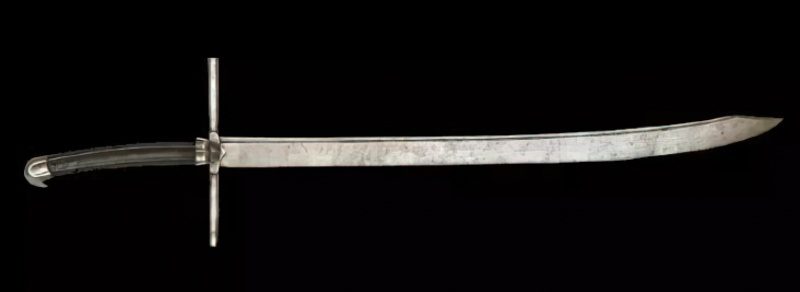
Germans also have the biggest knife in history, known as the Messer sword. These knife-looking swords can be split into groups of three – the Lange Messer or the smallest one-handed type, the large or Grosse Messer, and the later two-handed Kriegsmesser also used by the previously mentioned Landsknecht.
This sword first appeared in the 13th century as a budget alternative to the longswords used for battle and hunting, but its peak was in the 15th and 16th centuries when they were used in German sword martial arts.
- Blade – single-edged, straight, curved, half straight and half curved, pointy tip
- Guard – cruciform, narrowed
- Handle – straight, curved
- Length – 30 to 42 inches (75 to 105 cm)
- Weight – 2.2 to 3 lbs (1 to 1.4 kg)
9. Boar Sword

As its name suggests, the Boar Sword is a German sword designed for slaying wild boars. This sword was commonly used by nobles as a weapon to display both status and sword proficiency that the prestige of hunting might offer.
This massive two-handed weapon was meant to provide the last blow to injured boars and other beasts or square up against a similarly sized animal in direct confrontation. Originating in the 15th century, these weapons quickly became well-known as the nobility’s primary hunting instruments for ceremonial purposes.
- Blade – straight, unsharpened until the traverse bar, double-edged widened tip
- Guard – cruciform, traverse bar crossguard at the blade’s end
- Handle – straight, large two-handed ridge, large pommel
- Length – 43 to 53 inches (110 to 135 cm)
- Weight – 4.4 lbs (2 kg)
10. Panzerstecher

Specialized thrusting weapons were required upon the arrival of heavily armored knights who did not expose any skin outside of their armor. The German Panzerstecher, or “armor breaker,” was used to pierce armor from the 15th through the 18th century.
The blade length and weight of these swords made them more manageable and quicker to wield, and their sharpened points made short work of the holes in European armor.
- Blade – straight, double-edged, thinner toward the end
- Guard – cruciform, S-shaped, narrowed
- Handle – straight
- Length – 36 to 52 inches (90 to 130 cm)
- Weight – 3 lbs (1.3 kg)
11. Katzbalger

The German Katzbalger is the late German Renaissance Arming Sword, used as a secondary weapon and became synonymous with the legendary Landsknecht mercenary organization. Although particularly helpful for pushing through armor, this half-sword could also be used for cutting attacks since it featured a broader blade.
The term originates from the fact that it is often worn by its owner without any scabbard or sheath and instead is kept in place by ‘cat’s skin.
- Blade – straight, broad, double-edged, thinning blade tip
- Guard – cruciform, S-shaped, circular metal around it
- Handle – straight, broadened pommel
- Length – 28 to 31 inches (70 to 80 cm)
- Weight – 1.7 to 3.3 lbs ( 0.8 to 1.5 kg)
12. Dusack

The German Cutlass or cleaver was called the Dusack and was highly used in Germany throughout the 16th century as well as the latter years of the Habsburg Monarchy. It was both a popular weapon for everyday hunting, warfare, and dual fencing.
It was much like the German Side Sword as it featured a saber blade and side sword guard, making it useful in duels. As its popularity in duels grew, the guard was removed, leaving the handle with an open hole for the user’s hand.
- Blade – curved, single-edged, sharp pointy tip, broad
- Guard – S-shaped, half basket, form of metal quillons around it
- Handle – straight
- Length – 35 to 38 inches (90 to 95 cm)
- Weight – 3 lbs (1.4 kg)
13. Imperial German Swords

Eastern Europe left its mark on Germany regarding the trend of using curved cavalry sabers. These swords are named Imperial German swords because they are usually linked with either Prussia, because they follow the Prussian sword model, or the form and creation of the German Empire in the 19th century.

Most of these swords resemble each other and generally follow the same characteristics but can vary in curve, size, mass, and length. Most of them were brought and inspired by Britain during the Napoleonic wars. However, some were made and manufactured in Germany throughout the 19th and 20th century and used during World War I.
- Blade – straight, curved, single-edged, sharp tip
- Guard – basket, D-guard, P-guard
- Handle – curved, curved pommel
- Length – 31 to 30 inches (80 to 100 cm)
- Weight – 2.2 to 3.3 (1 to 1.5 kg)
14. Degen
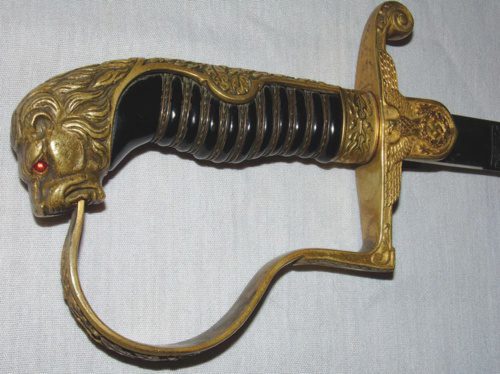
The German dress sword used in World War II by Nazi officers is called the SS Ehrendegen or the Honor Sword. It was designed by German artist Karl Diebitsch, who was responsible for the looks and uniformity of the German regalia. The weapon is in part designed after the 1899 Infantry saber.
It had all the symbols of Nazi Germany mainly with the swastika and SS symbols present. The Ehrendegen was generally worn by SS officers as part of their uniform and was not used in combat. The weapon was also given as a reward for serving the Reich. The rarest sword of this type is the Damascus Steel Degen.
- Blade – straight,
- Guard – D-shaped, P-shaped
- Handle – straight, curved pommel
- Length – 27 to 39 inches (70 to 100 cm)
- Weight – 1.7 to 3 lbs (0.8 to 1.4 kg)
Use of the German Swords
The Germans have found many uses for swords, from the smaller short swords called Seax, which were used in agriculture and hunting, to the larger Arming swords, which were used in full-on warfare during the Crusades and the Middle Ages. The elongated and enlarged swords, such as the longsword were used primarily during mounted warfare.
German swords may be used with either one or two hands, and they can be used for both cutting and thrusting. One can choose from many different sizes, from the shorter Ulfberht to the massive Zweihander, depending on the situational use.
Warfare
As one would expect, warfare was the primary use of German swords. Germanic swords had a significant impact on the rest of Europe since they were frequently used by commoners along with being the primary weapon of nobles.
Infantry utilized them to build shield walls, mounted forces used them to cut and break up pike formations, and trench dwellers relied on them to boost morale by charging the enemy.
Hunting
In the Holy Roman Empire, which included most of modern-day Germany, hunting was a popular pastime, and its aristocracy took great satisfaction in their achievements. Therefore, several other types of swords, such as the Boar Sword and the Hunting Sword, were developed to aid in the hunting process.
Ceremonial & Symbol of Status
Traditionally associated with German culture, swords serve as symbols of both martial prowess and social standing. They were and still are used during national ceremonies such as when an Emperor took the throne or an officer swore an oath to the country.
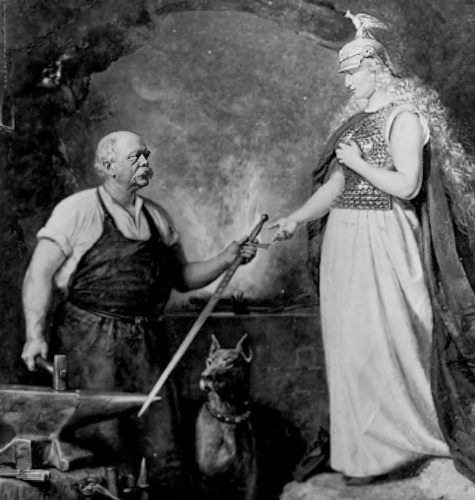
Martial Arts & Modern Day Usage
Due to the widespread use of swords in medieval Germany, the country’s modern-day martial arts traditions can be traced back to that era. Throughout the High Middle Ages, the Renaissance, and the Early Modern Era, the Fechtbucher style of fencing developed and flourished in Germany. The German longsword is used for fencing and duels, a sport greatly influenced by 14th-century fencer Johannes Liechtenauer.
In the modern day, a German sword is an excellent choice for a beginner’s first sword. The Longsword or Messer is an excellent training weapon for beginners since it can be used to practice with various other swords.
History of the German Swords
After the collapse of the Western Roman Empire in the Middle Ages, Germanic tribesmen gained a reputation for their expertise and ability to create formidable swords. Even though the ancient Germans may have preferred spears over swords, German swords are works of art and have influenced many.
All German Swords from the Middle Ages may be categorized as either straight or double-edged Oakeshott swords, each of which traces their lineage back to the Ulfberht or Viking swords. Many early tombs and graveyards reveal that they were mostly associated with nobles and the wealthy, but many smaller shortswords or daggers were also found.
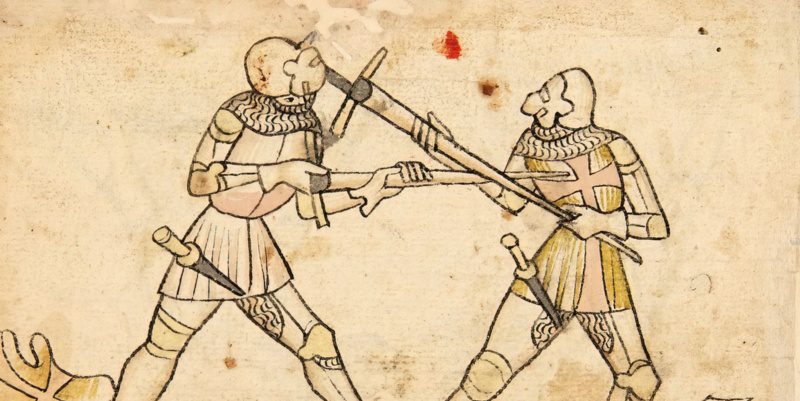
Larger two-handed swords like the Longsword, and later the Messer and Zweihander, helped boost the popularity and usage of German swords throughout the Holy Roman Empire (modern-day Germany). Beginning in the 1400s, Germany saw an influx of martial artists; by the 1500s, almost all knights and militia had been trained in swordsmanship.
German fencing guilds with long and short swords were designed to penetrate European armor. Pike and musket formations flourished alongside the German Renaissance, especially the Longsword, the Messer, and the Zweihander. But as time went on, particularly when the Rapier sword became more popular, the German Longsword fencing technique began to fade because it was seen as old-fashioned.
Some historians believe that it was the fall of the Holy Roman Empire in the Napoleonic Wars that directly led to the death of the unique German style of fencing.
Despite this, many German commanders and soldiers of the 19th and 20th centuries continue to display the same level of pride and reverence for German swords as they did centuries ago. Even in the modern-day World WarII era, German swords were considered very important and prestigious.

